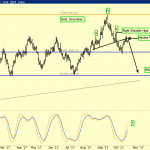Italy is the euro zone’s third-largest economy, and its economic figures rarely move the Euro. But the preliminary publication for Q3 2018, due on October 30th, will be different. Very different.
This time is different.
Rome vs. Brussels
Italy is clashing with the European Commission over its budget for 2019. The southern-European nation has drafted a budget that foresees a deficit to GDP ratio of 2.4%, breaching the EC’s request for a limit of 2%. Itay’s debt-to-GDP ratio stands at around 130%, second in the euro-zone only to Greece.
The Lega party insists on tax cuts while the 5-Start Movement demands a Citizens’ Income program. They say that without these measures, Italy will never emerge from its slow growth.
The government did not heed to warnings from Brussels and is submitting the budget to parliament on the same day.
Is growth slow? Yes. The economy did not boom in the early 2000s when its neighbors were on the rise, and it never saw an acceleration in growth in the post-crisis years. Back in Q2, the economy grew by only 0.2% while the euro-zone enjoyed a growth rate of 0.4%. Year over year, the nation’s economy expanded by 1.2% and the euro-zone by 2.1%.
Similar figures are expected this time: 0.2% QoQ and only 1% YoY in Q3.
Scenarios 1 and 2: Clash continues, and EUR/USD falls
If the actual data meets expectations, each side will keep digging in its heels. Italy will say that previous policies were failed and that debt-fueled growth is necessary to kick-start the economy. The EC will likely insist that the ongoing high debt-to-GDP ratio will mean that a smaller deficit is essential.
If the economy grew at an even slower pace, the clash would become even harsher. Both sides will feel they are vindicated in their positions.
In both scenarios, the EUR/USD will likely suffer as the crisis continues.






Leave A Comment